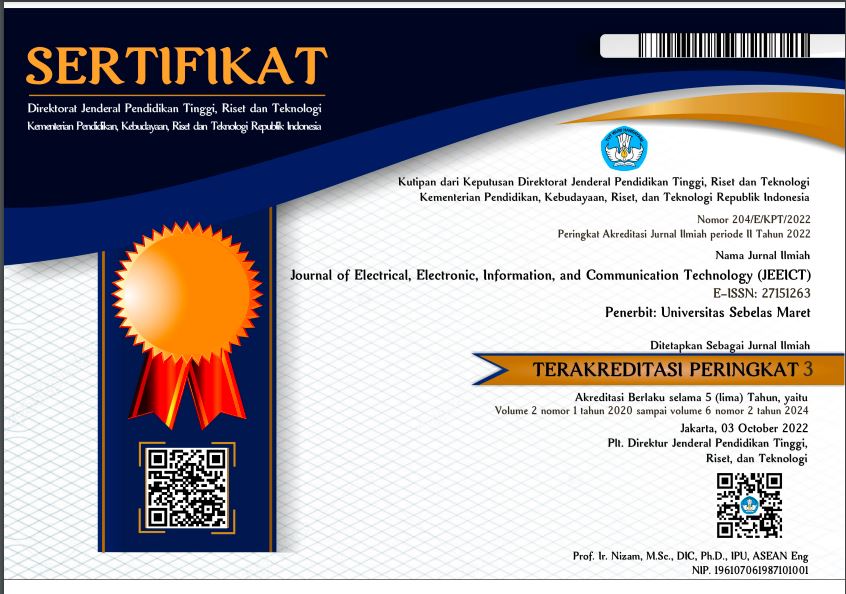Design of Hearing Aid and Speech Device for People Hearing Dissorders
Abstract
Deafness is a condition in which a person cannot hear due to a disturbance in his hearing organs. In communicating, most of the deaf sufferers only receive hearing aids. WHO (World Health Organization) initiated the Sound of Hearing 2030 by preventing hearing loss by 50% in 2015 and 90% in 2030. The main objective of Sound of Hearing is to develop a comprehensive, inclusive, and sustainable ear care program. Various studies on tools for deafness have been developed. However, this tool is only used to help deaf hearing but not to help speech learning (learn to speak). Thus we need hearing aids and speech learning tools for the deaf. This tool can be a government program, namely supporting a diffable-friendly Indonesia. The tool is designed like a headband, where the headband is composed of a row of vibrating modules that will be connected to the Google Assistant on a smartphone, so that any sound received by the Google Assistant will be sent to the tool to be converted into a vibration pattern. It is from these vibration patterns that a deaf person will get experience in recognizing sounds and learn to speak based on the vibration patterns that are formed. With the design of this tool, it hoped that it can help deaf people and get support from the community and government to create a diffable-friendly Indonesia.
Full Text:
PDFReferences
Hayek H E and Jessica N. 2014. “Sign To Letter Translator System using a Hand Glove”. IEEE. pp.146-150.
L Lintangsari A P. 2014. “Identifikasi Kebutuhan Mahasiswa Tuli Dalam Pembelajaran Bahasa Tulis”. Indonesian Journal of Disability Studies. Vol. 1. pp. 60-70.
R Gudyanga, E., Wadesango, N., Eliphanos, H., Gudyana. 2014. “A.: Challenges Faced by Students with Hearing Impairment in Bulawayo Urban Regular Schools.” Mediterranean Journal of Social Sciences, Vol. 5(9), pp. 445–451.
T. Schrepfer, J. Schacht, 2013. “Module in Neuroscience and Biobehavioral”. Psychology, pp. 2017l.
Parihar S P. 2019. “Internet of Things and Nodemcu”. JETIR Vol. 6. pp. 1085-1088.
Thomas Lenarz. 2017. “Cochlear implant – state of the art”. GMS Current Topics in Otorhinolaryngology - Head and Neck Surgery. Vol. 16. pp 1-29.
Benoit Godey, Vincent Darrouzet, Hermann Ruben, Isabelle Mosnier, Christine Poncet, Sébastien Schmerber, Eric Truy, Frédéric Venail, Christophe Vincent and Vincent Péan. 2020. “Comparing behind-the-ear and single-unit cohlear implant audio processors in 83 newly implanted subjects”. J Hear Sci. Vol 10(4). pp. 33–39.
Venkatachary Moguluri and Manisha Sriramoju. 2018. “Earless earphones: A device for deaf”. the 2nd International Conference on Communication and Electronics Systems (ICCES). pp. 659 – 662.
Ben Williges, Thomas Wesarg,Lorenz Jung, Leontien. Geven, Andreas Radeloff, and Tim Jurgen. 2019. “Spatial Speech-in-Noise Performance in Bimodal and Single-Sided Deaf Cochlear Implant Users’ Trends in Hearing. Vol 23. pp. 1–16.
Rachael Frush Holt. 2019. “Assistive Hearing Technology for Deaf and Hard-of-Hearing Spoken Language Learners”, Educ. Sci. Vol. 9, no. 153. pp. 1-22.
N Lederberg, A.R, Schick, B., Spencer, P.E. 2013. “Language and literacy development of deaf and hard-of-hearing children: Successes and challenges”. Dev. Psychol. Vol. 49. pp. 15–30
Miyamoto, R.T., Colson, B., Henning, S, Pisoni, D. 2017. “Cochlear implantation in infants below 12 months of age”. World J. Otorhinolaryngol. Head Neck Surg. Vol. 3. pp. 214–218
Michael F. Dorman, Sarah Cook Natale, Leslie Baxter Daniel M. Zeitler, Matthew L. Carlson, Artur Lorens, Henryk Skarzynski, Jeroen P. M. Peters, Jennifer H. Torres and Jack H. Noble. 2020. “Approximations to the Voice of a Cochlear Implant: Explorations With Single-Sided Deaf Listeners”. Trend in hearing Vol. 24. .pp. 1-12.
Vermeire, K., Landsberger, D., Van de Heyning, P., Voormolen, M., Kleine-Punte, A., Schatzer, R., & Zierhofer, C. 2015. “Frequency-place map for electrical stimulation in cochlear implants: Change over time”. Hearing Research. Vol. 326. pp. 8–14
arc Marschark, Thomastine Sarchet, Patricia Sapere and Carol Convertino. 2019. “Cochlear Implants and Classroom Learning among Deaf College Students”. Biomed J Sci & Tech. Vol. 18. Issue 5. pp. 13912- 13916.Refbacks
- There are currently no refbacks.







